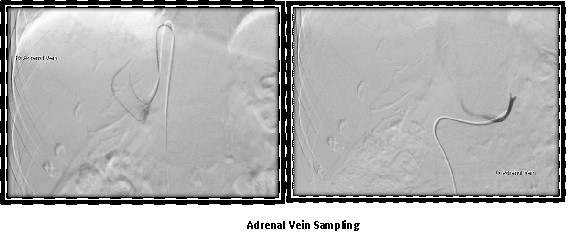 Adrenal Vein SamplingThe adrenal glands are situated above your kidneys and produce a hormone called aldosterone. Aldosterone is required to help regulate the sodium and potassium levels in your body. Adrenal Vein sampling is a procedure where the blood from both adrenal glands is sampled and the amount of hormone produced by each gland is measured. Preparation
You will need to fast for four hours before your appointment. This will ensure that your stomach is empty and eliminates the risk of aspiration (of fluid or food into the lungs). Please go to the peri-operative department on the day of your procedure and the staff there will prepare you and perform a set of routine observations before coming to the interventional radiology department for your procedure. Please continue to take all your regular medication with sips of water (unless otherwise instructed), including your blood pressure medication. Please inform the clerk at the time of booking your procedure if you are currently taking medication that thins your blood (eg Aspirin, Plavix, Warfarin) as these may need to be stopped a few days prior to your procedure. It may be useful to bring a LIST of medications to your appointment. You will need to have a blood test a few days prior to your appointment to assess your kidney function and blood clotting times. If your blood sample was taken outside the hospital then please obtain a copy of the results and bring it with you on the day of your procedure. You will need to bring any previous films (x-ray/CT/MRI/US) along to your appointment. It is important that you inform a member of staff as soon as possible if you are pregnant BEFORE the procedure is performed. If you suspect that you could be pregnant then you will need to have a pregnancy test at the hospital prior to the commencement of the procedure. This procedure involves the use of intravenous contrast; see Intravenous Contrast For health and safety reasons, family members cannot be present with you during the procedure. A staff member will be available to assist you at all times during the procedure if you have any concerns. A doctor will explain the procedure beforehand and you will be required to sign a consent form. If you require an interpreter, please inform the booking clerk at the time of booking. This procedure requires your groin area to be shaved. It is optional if you wish to personally attend to this prior to appointment. Procedure
You will be asked to remove your underwear and change into a hospital gown. All jewellery and metal objects in the area to be scanned will need to be removed as this can cause artefacts and obscure the images. An IV cannula will be inserted into a vein in your arm. A set of routine observations will be taken before the procedure begins (blood pressure, heart rate, etc). A cold cleaning solution will be applied to clean the skin in your groin area and a sterile sheet will be placed over your body. Local anaesthetic will be injected to numb the area around your groin. A needle will be inserted using ultrasound guidance into the vein. A soft wire is inserted through the needle into your vein and the needle is then replaced with a short plastic tube called a sheath. A catheter is then guided into your blood vessels until it reaches the adrenal glands. You will not feel the catheter moving inside your body. Blood samples are collected from both adrenal glands and from your cannula in your arm at the same time. Sometimes it is necessary to give you medication through the cannula in your arm. This medication is to stimulate the production of aldosterone and more blood samples are taken. After the Procedure
At the end of the procedure, the sheath will be removed and pressure applied on your groin area for about 10 to 15 minutes to stop bleeding. You will then be transferred to the recovery area. Your vital signs and groin will be monitored regularly after the procedure for swelling, oozing of blood and bruising. Moving too soon after the procedure may cause bleeding and bruising at the puncture site. The cannula in your arm will be removed just before you leave the peri-operative department. Go to your nearest Emergency Department or GP if you become unwell or have:
Staff will inform you what level of activity is suitable after your procedure. Results
A report regarding your procedure will be given to you before you leave to give to your referring doctor. It contains information about your procedure and any findings that your doctor should know about. Preparation Checklist
Don't forget to bring these along to your appointment
|

